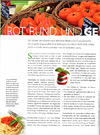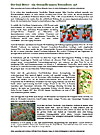NOPAL FEIGENKAKTUS – Aktuelle wissenschaftliche Studien | 15-25
15: Environ Entomol. 2007 Feb;36(1):53-7.
Aggregation pheromone of Metamasius spinolae (Coleoptera: Curculionidae): chemical analysis and field test.
Tafoya F, Whalon ME, Vandervoot C, Coombs AB, Cibrian-Tovar J.
Departamento de Biologia, Universidad Autonoma de Aguascalientes, 20100 Aguascalientes, Mexico. ftafoya@correo.uaa.mx
Male Metamasius spinolae (Gylh.) produce several volatile compounds that are likely constituents of its aggregation pheromone. These compounds were identified by volatile collections and gas chromatography (GC), followed by coupled gas chromatography-mass spectrometry (GC-MS), as 2-methyl-4-heptanone [1], 6-methyl-2hepten-4-one [2], and 2-hydroxy-2-methyl-4-heptanone [3]. Preliminary field experiments using synthetic racemates of these compounds showed that significantly more adult cactus weevils were caught in traps baited with the major single compound three or the 2 + 3 binary combination than in unbaited control traps. However, highest trap efficacy occurred with the 1 + 2 binary combination and a blend of all three synthetic compounds plus prickly pear. Potential uses for the cactus weevil pheromone and possible ways to increase trap captures are discussed.
Publication Types:
PMID: 17349116 [PubMed - indexed for MEDLINE]
16: Ann Bot (Lond). 2007 Apr;99(4):581-92. Epub 2007 Feb 13.
Seed anatomy and water uptake in relation to seed dormancy in Opuntia tomentosa (Cactaceae, Opuntioideae).
Orozco-Segovia A, Márquez-Guzmán J, Sánchez-Coronado ME, Gamboa de Buen A, Baskin JM, Baskin CC.
Instituto de Ecología, Universidad Nacional Autónoma de México, Apartado Postal 70-275, Ciudad Universitaria, 04510 México, D. F., México. aorozco@miranda.ecologia.unam.mx
BACKGROUND AND AIMS: There is considerable confusion in the literature concerning impermeability of seeds with 'hard' seed coats, because the ability to take up (imbibe) water has not been tested in most of them. Seeds of Opuntia tomentosa were reported recently to have a water-impermeable seed coat sensu lato (i.e. physical dormancy), in combination with physiological dormancy. However, physical dormancy is not known to occur in Cactaceae. Therefore, the aim of this study was to determine if seeds of O. tomentosa are water-permeable or water-impermeable, i.e. if they have physical dormancy. METHODS: The micromorphology of the seed coat and associated structures were characterized by SEM and light microscopy. Permeability of the seed-covering layers was assessed by an increase in mass of seeds on a wet substrate and by dye-tracking and uptake of tritiated water by intact versus scarified seeds. KEY RESULTS: A germination valve and a water channel are formed in the hilum-micropyle region during dehydration and ageing in seeds of O. tomentosa. The funicular envelope undoubtedly plays a role in germination of Opuntia seeds via restriction of water uptake and mechanical resistance to expansion of the embryo. However, seeds do not exhibit any of three features characteristic of those with physical dormancy. Thus, they do not have a water-impermeable layer(s) of palisade cells (macrosclereids) or a water gap sensu stricto and they imbibe water without the seed coat being disrupted. CONCLUSIONS: Although dormancy in seeds of this species can be broken by scarification, they have physiological dormancy only. Further, based on information in the literature, it is concluded that it is unlikely that any species of Opuntia has physical dormancy. This is the first integrative study of the anatomy, dynamics of water uptake and dormancy in seeds of Cactaceae subfamily Opuntioideae.
Publication Types:
PMID: 17298989 [PubMed - indexed for MEDLINE]
17: Planta Med. 1999 Oct;65(7):632-5.
Amino acid composition and betaxanthin formation in fruits from Opuntia ficus-indica.
Stintzing FC, Schieber A, Carle R.
Institut für Lebensmitteltechnologie, Universität Hohenheim, Stuttgart, Germany.
In contrast to earlier reports high levels of taurine (2-aminoethanesulfonic acid) were found in fruit juices of three cultivars of Opuntia ficus-indica (L.) Mill. Whereas the occurrence of taurine in plant tissue was thought to be restricted to algae, fungi, and the endosperm of some higher plants, prickly pear proved to be a rich source of dietary taurine. Using L-taurine as the amino compound, a new betaxanthin was synthesized by partial synthesis. On the basis of chemical and spectral evidence its structure was determined to be the taurine-immonium-conjugate of betalamic acid. Also betalamic acid could be detected in yellow and orange coloured cultivars of Opuntia ficus-indica for the first time. In spite of the high levels of L-taurine accompanied by the occurrence of betalamic acid, the corresponding betaxanthin could not be detected in the fruit tissue.
PMID: 17260288 [PubMed]
18: Phytother Res. 2007 Apr;21(4):344-6.
Opuntia ficus indica (L.) Mill. mucilages show cytoprotective effect on gastric mucosa in rat.
Galati EM, Monforte MT, Miceli N, Mondello MR, Taviano MF, Galluzzo M, Tripodo MM.
Pharmaco-Biological Department, School of Pharmacy, University of Messina, Vill. SS.Annunziata, Messina, Italy. emgalati@unime.it
Opuntia ficus indica cladodes possess a protective action against ethanol-induced ulcer in the rat. The major components of cladodes are carbohydrate polymers, mainly mucilages and pectin. To clarify the cytoprotective effects of cladodes on experimental ethanol-induced ulcer in rat, mucilages and pectin were extracted and were administered instead of cladodes. The above mentioned effects induced by cladodes may be attributed to mucilages, and not significantly to pectin.
PMID: 17221828 [PubMed - indexed for MEDLINE]
19: J Ethnopharmacol. 2007 May 4;111(2):315-21. Epub 2006 Dec 2.
Effect of hyaluronic acid and polysaccharides from Opuntia ficus indica (L.) cladodes on the metabolism of human chondrocyte cultures.
Panico AM, Cardile V, Garufi F, Puglia C, Bonina F, Ronsisvalle S.
Department of Pharmaceutical Sciences, Faculty of Pharmacy, University of Catania, Viale Andrea, Doria 6, 95125 Catania, Italy. panico@unict.it
Conventional medications in articular disease are often effective for symptom relief, but they can also cause significant side effects and do not slow the progression of the disease. Several natural substances have been shown to be effective as non-steroidal anti-inflammatory drugs at relieving the symptoms of osteoarthritis (OA), and preliminary evidence suggests that some of these compounds may exert a favourable influence on the course of the disease. In this study, we assay the anti-inflammatory/chondroprotective effect of some lyophilised extracts obtained from Opuntia ficus indica (L.) cladodes and of hyaluronic acid (HA) on the production of key molecules released during chronic inflammatory events such as nitric oxide (NO), glycosaminoglycans (GAGs), prostaglandins (PGE(2)) and reactive oxygen species (ROS) in human chondrocyte culture, stimulated with proinflammatory cytokine interleukin-1 beta (IL-1 beta). Further the antioxidant effect of these extracts was evaluated in vitro employing the bleaching of the stable 1,1-diphenyl-2-picrylhydrazyl radical (DPPH test). All the extracts tested in this study showed an interesting profile in active compounds. Particularly some of these extracts were characterized by polyphenolic and polysaccharidic species. In vitro results pointed out that the extracts of Opuntia ficus indica cladodes were able to contrast the harmful effects of IL-1 beta. Our data showed the protective effect of the extracts of Opuntia ficus indica cladodes in cartilage alteration, which appears greater than that elicited by hyaluronic acid (HA) commonly employed as visco-supplementation in the treatment of joint diseases.
Publication Types:
PMID: 17196777 [PubMed - indexed for MEDLINE]
20: J Hazard Mater. 2007 Jun 1;144(1-2):240-8. Epub 2006 Oct 12.
A combined electrocoagulation-sorption process applied to mixed industrial wastewater.
Linares-Hernández I, Barrera-Díaz C, Roa-Morales G, Bilyeu B, Ureña-Núñez F.
Universidad Autónoma del Estado de México, Facultad de Química, Paseo Colón intersección Paseo Tollocan S/N, C.P. 50120, Toluca, Estado de México, Mexico.
The removal of organic pollutants from a highly complex industrial wastewater by a aluminium electrocoagulation process coupled with biosorption was evaluated. Under optimal conditions of pH 8 and 45.45 Am(-2) current density, the electrochemical method yields a very effective reduction of all organic pollutants, this reduction was enhanced when the biosorption treatment was applied as a polishing step. Treatment reduced chemical oxygen demand (COD) by 84%, biochemical oxygen demand (BOD(5)) by 78%, color by 97%, turbidity by 98% and fecal coliforms by 99%. The chemical species formed in aqueous solution were determined. The initial and final pollutant levels in the wastewater were monitored using UV-vis spectrometry and cyclic voltammetry. Finally, the morphology and elemental composition of the biosorbent was characterized with scanning electron microscopy (SEM) and energy dispersion spectra (EDS).
Publication Types:
PMID: 17118541 [PubMed - indexed for MEDLINE]
21: Steroids. 2006 Dec;71(13-14):1073-7. Epub 2006 Nov 16.
Two novel C29-5beta-sterols from the stems of Opuntia dillenii.
Jiang J, Li Y, Chen Z, Min Z, Lou F.
Department of Phytochemistry, China Pharmaceutical University, Nanjing 210038, PR China. njjjq@yahoo.com.cn
Two novel C29-5beta-sterols, opuntisterol [(24R)-24-ethyl-5beta-cholest-9-ene-6beta,12alpha-diol] (1) and opuntisteroside [(24R)-24-ethyl-6beta-[(beta-d-glucopyranosyl)oxy]-5beta-cholest-9-ene-12alpha-ol] (2), together with nine known compounds, beta-sitosterol (3), taraxerol (4), friedelin (5), methyl linoleate (6), 7-oxositosterol (7), 6beta-hydroxystigmast-4-ene-3-one (8), daucosterol (9), methyl eucomate (10) and eucomic acid (11), were isolated from the stems of Opuntia dillenii collected in Guizhou Province, China. Their structures were elucidated mainly by spectroscopic analysis. The absolute configuration of 1 were deduced from comparative 1H NMR data of the (S)- and (R)-methoxyphenyl acetate derivatives. Compounds 6-8, 10 and 11 were isolated from O. dillenii for the first time.
Publication Types:
PMID: 17112557 [PubMed - indexed for MEDLINE]
22: Am Nat. 2006 Nov;168(5):608-16. Epub 2006 Oct 5.
Plant reproductive allocation predicts herbivore dynamics across spatial and temporal scales.
Miller TE, Tyre AJ, Louda SM.
School of Biological Sciences, University of Nebraska, Lincoln, Nebraska 68588, USA. tmiller2@unl.edu
Life-history theory suggests that iteroparous plants should be flexible in their allocation of resources toward growth and reproduction. Such plasticity could have consequences for herbivores that prefer or specialize on vegetative versus reproductive structures. To test this prediction, we studied the response of the cactus bug (Narnia pallidicornis) to meristem allocation by tree cholla cactus (Opuntia imbricata). We evaluated the explanatory power of demographic models that incorporated variation in cactus relative reproductive effort (RRE; the proportion of meristems allocated toward reproduction). Field data provided strong support for a single model that defined herbivore fecundity as a time-varying, increasing function of host RRE. High-RRE plants were predicted to support larger insect populations, and this effect was strongest late in the season. Independent field data provided strong support for these qualitative predictions and suggested that plant allocation effects extend across temporal and spatial scales. Specifically, late-season insect abundance was positively associated with interannual changes in cactus RRE over 3 years. Spatial variation in insect abundance was correlated with variation in RRE among five cactus populations across New Mexico. We conclude that plant allocation can be a critical component of resource quality for insect herbivores and, thus, an important mechanism underlying variation in herbivore abundance across time and space.
Publication Types:
PMID: 17080360 [PubMed - indexed for MEDLINE]
23: Dis Colon Rectum. 2006 Nov;49(11):1768-71.
Fecal impaction in adults: report of 30 cases of seed bezoars in the rectum.
Eitan A, Bickel A, Katz IM.
Department of Surgery, Western Galilee Hospital, P.O.B. 21, Naharia 22100, Israel.
PURPOSE: Seed bezoars in the rectum have been considered an uncommon cause of fecal impaction in adults. Although there have been several reports on sunflower seed bezoars, seed bezoars from the fruit of the prickly pear cactus and watermelon have received little notice. This study was designed to determine the frequency of fecal impaction by seed bezoars in the rectum and their clinical characteristics in adults. METHODS: A retrospective review of the medical records of patients hospitalized with the diagnosis of fecal impaction during a ten-year period. RESULTS: During the study period (January 1996 to December 2005), 55 patients were hospitalized at the Western Galilee Hospital, in northern Israel, with the diagnosis of fecal impaction. Phytobezoars were found in 30 patients (55 percent). The seed bezoars were composed of prickly pear seeds in 12 patients, watermelon seeds in 10 patients, sunflower seeds in 4 patients, popcorn kernels in 1 patient, and pomegranate seeds in 1 patient. The Jew:Arab ratio for seed bezoars was 7:23. Seventy-three patients had seedless fecal masses with a Jew:Arab ratio of 58:15. All 30 patients with bezoar underwent digital disimpaction under general anesthesia. Only 21 of 73 patients with seedless fecal masses were treated under general anesthesia. CONCLUSIONS: Seed bezoars found in the rectum were the most common cause of fecal impaction requiring hospitalization, probably to the result of the eating habits in the Middle East. The consumption of seeds with shell fragments or fruits containing many seeds (such as the prickly pear) should be accompanied by the awareness that large quantities may cause fecal impaction.
PMID: 17036204 [PubMed - indexed for MEDLINE]
24: Plant Foods Hum Nutr. 2006 Sep;61(3):115-9. Epub 2006 Sep 22.
Physico-chemical changes in cladodes (nopalitos) from cultivated and wild cacti (Opuntia spp.).
Betancourt-Domínguez MA, Hernández-Pérez T, García-Saucedo P, Cruz-Hernández A, Paredes-López O.
Departamento de Biotecnología y Bioquímica, Centro de Investigación y de Estudios Avanzados del IPN, Unidad Irapuato, Apartado postal 629, Irapuato, Gto, 36500, México.
Physico-chemical and nutritional composition from four different nopalitos (young cladodes from cacti): Blanco sin Espinas, Blanco con Espinas, Verde Valtierrilla (cultivated materials) and a wild material from the central region of México were studied at different sizes of harvesting. The first three are commercial crops. None of the tested materials exhibited superior characteristics in all of the evaluated parameters in relation to each one of them. In various cases properties of the wild crop were comparable, if not superior, to commercial ones. Some important changes were observed in total soluble solids, water content, texture, acidity and pH as affected by size of cladode and specific crop. Most cladode samples appear to be a good source of beta-carotene and lutein. The presence of these compounds is important for human nutraceutical purposes.
Publication Types:
PMID: 17031603 [PubMed - indexed for MEDLINE]
25: J Ind Microbiol Biotechnol. 2006 Nov;33(11):921-8. Epub 2006 Aug 17.
Effect of different fermentation conditions on the kinetic parameters and production of volatile compounds during the elaboration of a prickly pear distilled beverage.
Arrizon J, Calderón C, Sandoval G.
Centro De Investigación y Asistencia en Tecnología y Diseño del Estado de Jalisco (CIATEJ), Normalistas 800, Colinas de la Normal, 44270 Guadalajara, Jalisco, Mexico. jparrizon@ciatej.net.mx
An experimental design considering thermal treatment of must, yeast strain, prickly pear variety and degree of ripeness was chosen to evaluate the fermentation behavior and generation of volatile compounds, during the elaboration of a distilled beverage from prickly pear. Four Mexican prickly pear varieties were characterized physically and two of them were selected for fermentation studies. The thermal treatment of the must showed the highest statistical influence on fermentation behavior and production of volatile compounds, followed by prickly pear variety, then yeast strain and finally the degree of ripeness was the least statistically significant factor. The growth rate increased when the thermal treatment was applied whereas the ethanol production rate and alcoholic efficiency were unaffected. The results also suggested that thermal treatment was effective for inhibition of microbial contamination. As regards volatile compounds production, acetic acid and methanol decreased while other volatiles increased when the thermal treatment was applied. Despite the influence of thermal treatment, prickly pear variety strongly influences the volatile profile of fermented musts.
Publication Types:
PMID: 16915396 [PubMed - indexed for MEDLINE]




















